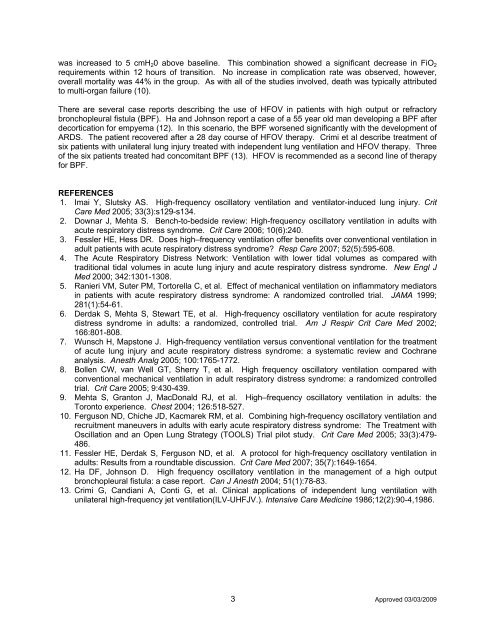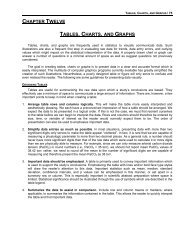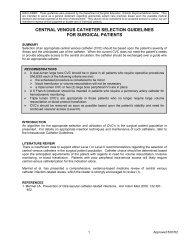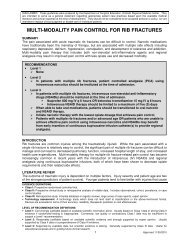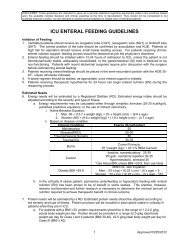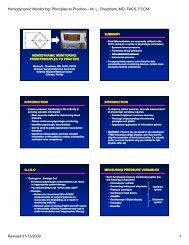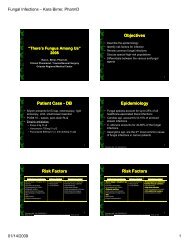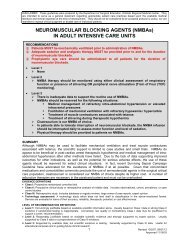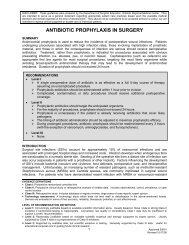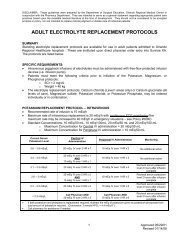THE USE OF HIGH FREQUENCY OSCILLATORY VENTILATION ...
THE USE OF HIGH FREQUENCY OSCILLATORY VENTILATION ...
THE USE OF HIGH FREQUENCY OSCILLATORY VENTILATION ...
- No tags were found...
You also want an ePaper? Increase the reach of your titles
YUMPU automatically turns print PDFs into web optimized ePapers that Google loves.
was increased to 5 cmH 2 0 above baseline. This combination showed a significant decrease in FiO 2requirements within 12 hours of transition. No increase in complication rate was observed, however,overall mortality was 44% in the group. As with all of the studies involved, death was typically attributedto multi-organ failure (10).There are several case reports describing the use of HFOV in patients with high output or refractorybronchopleural fistula (BPF). Ha and Johnson report a case of a 55 year old man developing a BPF afterdecortication for empyema (12). In this scenario, the BPF worsened significantly with the development ofARDS. The patient recovered after a 28 day course of HFOV therapy. Crimi et al describe treatment ofsix patients with unilateral lung injury treated with independent lung ventilation and HFOV therapy. Threeof the six patients treated had concomitant BPF (13). HFOV is recommended as a second line of therapyfor BPF.REFERENCES1. Imai Y, Slutsky AS. High-frequency oscillatory ventilation and ventilator-induced lung injury. CritCare Med 2005; 33(3):s129-s134.2. Downar J, Mehta S. Bench-to-bedside review: High-frequency oscillatory ventilation in adults withacute respiratory distress syndrome. Crit Care 2006; 10(6):240.3. Fessler HE, Hess DR. Does high–frequency ventilation offer benefits over conventional ventilation inadult patients with acute respiratory distress syndrome? Resp Care 2007; 52(5):595-608.4. The Acute Respiratory Distress Network: Ventilation with lower tidal volumes as compared withtraditional tidal volumes in acute lung injury and acute respiratory distress syndrome. New Engl JMed 2000; 342:1301-1308.5. Ranieri VM, Suter PM, Tortorella C, et al. Effect of mechanical ventilation on inflammatory mediatorsin patients with acute respiratory distress syndrome: A randomized controlled trial. JAMA 1999;281(1):54-61.6. Derdak S, Mehta S, Stewart TE, et al. High-frequency oscillatory ventilation for acute respiratorydistress syndrome in adults: a randomized, controlled trial. Am J Respir Crit Care Med 2002;166:801-808.7. Wunsch H, Mapstone J. High-frequency ventilation versus conventional ventilation for the treatmentof acute lung injury and acute respiratory distress syndrome: a systematic review and Cochraneanalysis. Anesth Analg 2005; 100:1765-1772.8. Bollen CW, van Well GT, Sherry T, et al. High frequency oscillatory ventilation compared withconventional mechanical ventilation in adult respiratory distress syndrome: a randomized controlledtrial. Crit Care 2005; 9:430-439.9. Mehta S, Granton J, MacDonald RJ, et al. High–frequency oscillatory ventilation in adults: theToronto experience. Chest 2004; 126:518-527.10. Ferguson ND, Chiche JD, Kacmarek RM, et al. Combining high-frequency oscillatory ventilation andrecruitment maneuvers in adults with early acute respiratory distress syndrome: The Treatment withOscillation and an Open Lung Strategy (TOOLS) Trial pilot study. Crit Care Med 2005; 33(3):479-486.11. Fessler HE, Derdak S, Ferguson ND, et al. A protocol for high-frequency oscillatory ventilation inadults: Results from a roundtable discussion. Crit Care Med 2007; 35(7):1649-1654.12. Ha DF, Johnson D. High frequency oscillatory ventilation in the management of a high outputbronchopleural fistula: a case report. Can J Anesth 2004; 51(1):78-83.13. Crimi G, Candiani A, Conti G, et al. Clinical applications of independent lung ventilation withunilateral high-frequency jet ventilation(ILV-UHFJV.). Intensive Care Medicine 1986;12(2):90-4,1986.3 Approved 03/03/2009


